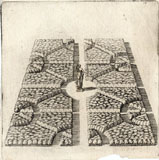Early Stuart consolidation
Under James I and Charles I, the dominance of British print production by immigrants from the continent continued, including such notable engravers as Francis Delaram and various members of the de Passe family. But there were an increasing number of native-born artists, including Renold Elstrack and John Payne. Such men served a growing market for printed images of all kinds. There was an upsurge in the woodcut trade in the Jacobean period compared with the 16th century, and engravings also became increasingly common. Either as a cause or as a result of this, these years see the intensification of a trend that had begun in Elizabeth’s last years, of the emergence of specialist dealers in prints, in the form of the partners Sudbury and Humble, and their rivals, Compton and Henry Holland. In addition to dealing in prints produced in England, such men also commissioned work overseas for the English market, as with the volume of portraits of leading Englishmen entitled Herωologia (1620).
 As for the types of images that
were produced, portraits remained dominant, and there are some wonderful printed images of
members of the early Stuart royal family and their courtly entourage, including a
fascinating portrait of
As for the types of images that
were produced, portraits remained dominant, and there are some wonderful printed images of
members of the early Stuart royal family and their courtly entourage, including a
fascinating portrait of
 Charles I on
horseback by Elstrack in which the head of the figure was adapted in successive versions to
do justice to the prince’s growing maturity in appearance: the original version dates from
1612, and subsequent versions date from about 1616 and from 1625, the latter the year in
which Charles ascended to the throne on the death of James I.
Charles I on
horseback by Elstrack in which the head of the figure was adapted in successive versions to
do justice to the prince’s growing maturity in appearance: the original version dates from
1612, and subsequent versions date from about 1616 and from 1625, the latter the year in
which Charles ascended to the throne on the death of James I.
Other, more miscellaneous genres also flourished at this time. Engraved title-pages became increasingly common, while new genres were introduced, including botanical prints derived from Dutch models, sets of allegorical figures, political prints and satires of popular vices. There are also some fascinating glimpses of Jacobean and Caroline culture, such as the engravings of the triumphal arches that lined the streets of the City of London for the Coronation of James I, or the etching of the gardens of Wilton House by their designer, Isaac de Caus.